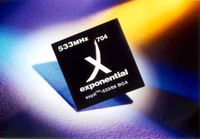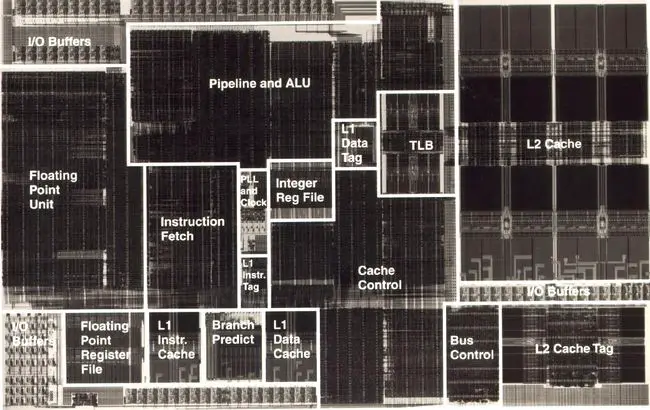(→Overview) |
|||
| Line 22: | Line 22: | ||
| socket = | | socket = | ||
}} | }} | ||
| − | '''X704''' (stylized as '''X<sup>704</sup>''') was a family of high-performance [[PowerPC]] [[microprocessor]]s announced by [[Exponential Technology]] in [[1996]]. At the time, these chips ran over three tims the clock rate as [[Motorola]]'s/[[IBM]]'s or [[Intel]]'s (albeit not as fast in direct performance). Exponential | + | '''X704''' (stylized as '''X<sup>704</sup>''') was a family of high-performance [[PowerPC]] [[microprocessor]]s announced by [[Exponential Technology]] in [[1996]]. At the time, these chips ran over three tims the clock rate as [[Motorola]]'s/[[IBM]]'s or [[Intel]]'s (albeit not as fast in direct performance). While Exponential experience a few bumps in the road during the final stages, it did not severley hurt their competitive advantage. Exponential's chips were also caught in the crossfire between [[Apple]] and [[Macintosh clone]] manufacturers, which ultimately sealed their fate (See [[#History|§ History]]). |
| − | == | + | == History == |
{{see also|Exponential Technology}} | {{see also|Exponential Technology}} | ||
Exponential took on a very ambitious challenge of designing a PowerPC [[microarchitecture]] from the ground up that could operate at extremely high clock frequency for the time - 533 MHz. Comparable chips at the time of Exponential founding were operating at only 50-75 MHz max. By [[1993]] the idea was backed by [[Apple]] and their CEO [[wikipedia:Michael Spindler|Michael Spindler]] which became the principal investor of the newly created company, [[exponential technology|Exponential]]. | Exponential took on a very ambitious challenge of designing a PowerPC [[microarchitecture]] from the ground up that could operate at extremely high clock frequency for the time - 533 MHz. Comparable chips at the time of Exponential founding were operating at only 50-75 MHz max. By [[1993]] the idea was backed by [[Apple]] and their CEO [[wikipedia:Michael Spindler|Michael Spindler]] which became the principal investor of the newly created company, [[exponential technology|Exponential]]. | ||
Revision as of 23:03, 30 June 2016
| X704 | |

| |
| 533MHz X704 Promotional Picture | |
| Developer | Exponential Technology |
| Manufacturer | Hitachi |
| Type | Microprocessors |
| Introduction | October 21, 1996 (announced) |
| ISA | PowerPC |
| µarch | X704 |
| Word size | 32 bit 4 octets
8 nibbles |
| Process | 500 nm 0.5 μm
5.0e-4 mm |
| Technology | BiCMOS |
| Clock | 400 MHz-533 MHz |
| Package | CBGA-356 |
X704 (stylized as X704) was a family of high-performance PowerPC microprocessors announced by Exponential Technology in 1996. At the time, these chips ran over three tims the clock rate as Motorola's/IBM's or Intel's (albeit not as fast in direct performance). While Exponential experience a few bumps in the road during the final stages, it did not severley hurt their competitive advantage. Exponential's chips were also caught in the crossfire between Apple and Macintosh clone manufacturers, which ultimately sealed their fate (See § History).
History
- See also: Exponential Technology
Exponential took on a very ambitious challenge of designing a PowerPC microarchitecture from the ground up that could operate at extremely high clock frequency for the time - 533 MHz. Comparable chips at the time of Exponential founding were operating at only 50-75 MHz max. By 1993 the idea was backed by Apple and their CEO Michael Spindler which became the principal investor of the newly created company, Exponential.
In 1994 Apple and Exponential signed a juint development agreement and later that year they formed an agreement with Hitachi which agreed to manufacture their chip at their BiCMOS foundry. By 1996 with their chip just months away from engineering sample, Apple's CEO, then Gil Amelio extended their agreement to gain exclusive rights to the chip for the first nine months of volume production. The deal included a $5 million prepayment - a payment Apple never delivered.
First samples of the X704 came back running at only 410 MHz, 75% of the expected speed. Exponential attributed the issue to a bug in their custom design tools. This pushed back the deliver date to March of 1997. Even then, the chip would have been considerably faster than the fastest chips on the market at the time - Intel's Klamath which ran as high as 233 MHz.
By February of 1997, the X704 was at the final stages. Apple was in a fairly bad shape at the time, with massive layoffs on the horizon; just a month later they acquired NEXT software for $430 million, bringing back Steve Jobs as an advisers and replacing key Apple upper management. Around the same time, Exponential displayed an X704-based machine to journalists at the LA Dreamworks Studios, running complex 3D animations and wowing the audiences. Following Exponential progress IBM announced a new chip: the Mach 5; the chip didn't actually arrive until 5 months later. While clocked at only 250 MHz, its considerably larger cache and wider datapath promised to match X704's performance. IBM chip was also to be manufactured on their new 0.25 µm process (compared to X704's 0.5 µm). Apple eventually went with IBM's chip but only for a short time as by 1998 they went over to PPC 750 series. In a meeting that took place on March 3 1997 Apple told Exponential that with the lay off of thousands employees they will no longer be able to design a system around the X704 chip. This decision had devastating consequences for Exponential which relied on Apple's deal which would've meant hundreds of millions of dollars in revenue.
Running out of cache, as a last resort, Exponential attempted to close a number of deals with a number of Macintosh clone manufacturers. Exponential had deals on the table with companies such as Umax Computer Corporation, Power Computing Corporation, and MaxxBoxx. Clone deals where on condition Apple would modify their ROM. In mid-April Apple agreed to provide clones with a modified ROM but at higher charge (supposedly proportional to the processor speed used).
On April 17, 1997 Apple cancelled their existing contract with Exponential, invoking the 'design flaw' clause citing the slower clock speed as the reason. Under the contract Apple was required to pay $1.4 million cancellation fee. The $1.4 was never paid; money that would have more than likely kept Exponential going for a fair mount of time. As a last straw; Apple never delivered the promised modified ROM.
The likely intentional final steps by Apple to block any and all clones from getting their hand at the X704 halted any sale deal Exponential had. On May 8 Exponential ended up laying off 25% of their engineers. After additional attempts by Exponential to collect on the cancellation fees Exponential finally shut down their development center in San Jose on May 15.
On September 1 1997, Exponential sold their X704 patent portfolio, which amounted to over 50 patents, to S3 Inc. Many of the technologies in these patents were used in Intel's Pentium II processors. On December 1998 S3 Inch and Intel announced a 10-year patent cross-licensing agreement which gave Intel to much of Exponential's original technology.
Architecture
- Main article: X704 Microarchitecture
| This section is empty; you can help add the missing info by editing this page. |
Die Shot
Documents
Manuals
- X704 Technical Summary, 1996
Papers
- C. A. Maier et al., "A 533-MHz BiCMOS superscalar RISC microprocessor," in IEEE Journal of Solid-State Circuits, vol. 32, no. 11, pp. 1625-1634, Nov 1997. doi: 10.1109/4.641683
| designer | Exponential Technology + |
| first announced | October 21, 1996 + |
| full page name | exponential technology/x704 + |
| instance of | microprocessor family + |
| instruction set architecture | PowerPC + |
| main designer | Exponential Technology + |
| manufacturer | Hitachi + |
| microarchitecture | X704 + |
| name | X704 + |
| package | CBGA-356 + |
| process | 500 nm (0.5 μm, 5.0e-4 mm) + |
| technology | BiCMOS + |
| word size | 32 bit (4 octets, 8 nibbles) + |

